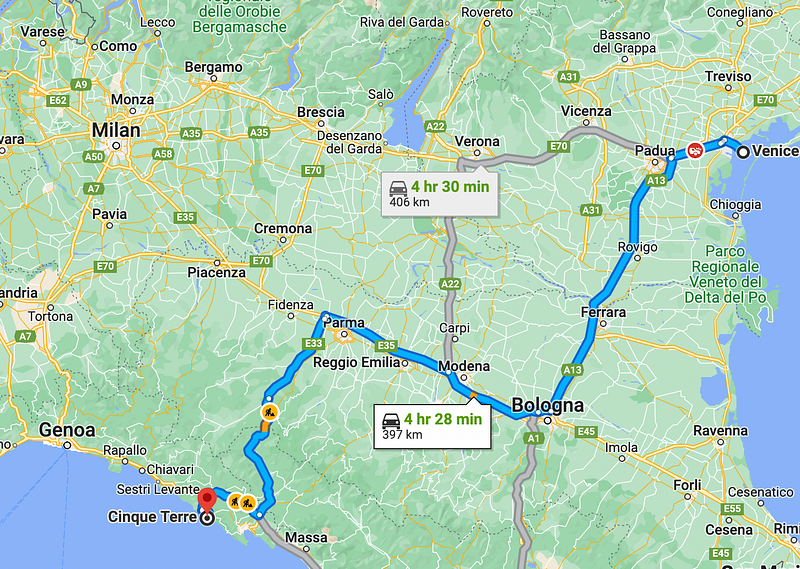Navigating the Challenges of Electric Vehicle Travel
Written on
Chapter 1: A Summer Journey Begins
This summer, we embarked on an unforgettable road trip through Italy, visiting stunning destinations like Venice and the picturesque Cinque Terre. However, our experience with charging the electric vehicle (EV) was far from seamless.
After flying from Amsterdam to Bergamo, we rented a Renault Zoe EV equipped with an automatic transmission and a range of approximately 300 kilometers. Our first leg of the journey was from Bergamo to Venice, which we completed in about 2.5 hours. The car performed impressively, offering two driving modes: an eco mode that limited speed to 100 km/h for optimal battery conservation, and a standard mode allowing speeds of up to 150 km/h at the cost of range.
Despite our smooth drive, we encountered a hiccup when we missed a turn, costing us an additional 20 kilometers of range. As we entered Venice, we were down to just 25 kilometers of battery. Thankfully, we reached our hotel and discovered a nearby charging station, but it made us wonder what we would have done otherwise.
The rental company provided us with an Enel-X charging card, which proved useful when we located a charging station in the city. Initiating the charge was straightforward, which was a relief.
Charging Challenges Ahead!
The beauty of Cinque Terre is undeniable, but as we drove from Venice, the 400-kilometer stretch presented a challenge since our car's range was only 300 kilometers. We knew we needed to recharge before arriving.
We made a stop near Bologna, believing it would be an ideal place to recharge and take a break. However, we soon learned that the charging station was not from Enel-X but from a different provider, Chargepoint. This required us to download an app, create an account, and input payment details before we could start charging. The process took nearly ten minutes, leaving us to stand in the sweltering heat of over 38 degrees Celsius.
Our first charging experience in Venice had been during the night while we relaxed at our hotel, but this time we faced various obstacles. With the Renault Zoe’s limited charging capacity, even a 150 kW/h fast charger took much longer than expected. The charging rate dropped after a while, leaving us frustrated and waiting under a tree for over an hour.
Once charged, we set off for Cinque Terre, but our worries were far from over. Upon arrival, we discovered the only charging station was 15 kilometers behind us, forcing us to retrace our steps through challenging terrain.
After reaching our hotel with only 25 kilometers of range left, we learned of a nearby private charging station. Gratefully, the owner allowed us to charge for thirty minutes, giving us an additional 150 kilometers of range. Finally, we could enjoy our time in Cinque Terre before heading to the French Riviera.

Chapter 2: Evaluating the Electric Experience
The overall experience of driving an electric vehicle on this journey was rated a 5 out of 10. Here’s a breakdown of the pros and cons:
Advantages of Driving an EV:
- Impressive Acceleration: The EV handled beautifully, providing a quick response akin to that of a cheetah.
- Rapid Cooling: The air conditioning felt more efficient compared to gasoline cars.
- Easy to Handle: The steering was light and responsive.
- Environmentally Friendly: Electric cars are better for the planet, provided the electricity comes from renewable sources.
- Cost-Effective: We only spent about €80 on charging for 1,500 kilometers over six days.
Drawbacks of Electric Vehicle Travel:
- Finding Charging Stations: The search for charging points proved to be a significant hassle, especially on long trips.
- Diverse Charging Systems: Many stations required app downloads and account setups, complicating the process.
- Compatibility Issues: Not every charging socket fit our vehicle, and we often struggled to find a suitable match.
- Time-Consuming Charging: Waiting for the car to charge could take longer than anticipated, especially in remote locations.
- Limited Fast Chargers: Discovering fast chargers on the route can be challenging, and access may be restricted.
As we navigated the Italian countryside, it became clear that the current EV infrastructure requires substantial improvement. Long road trips in electric vehicles can lead to frustration and anxiety, particularly regarding battery life and charging availability.
For those planning extended journeys, a gasoline car may be the more practical choice. While electric vehicles are fantastic for urban travel, they are not yet suitable for multi-day excursions.
